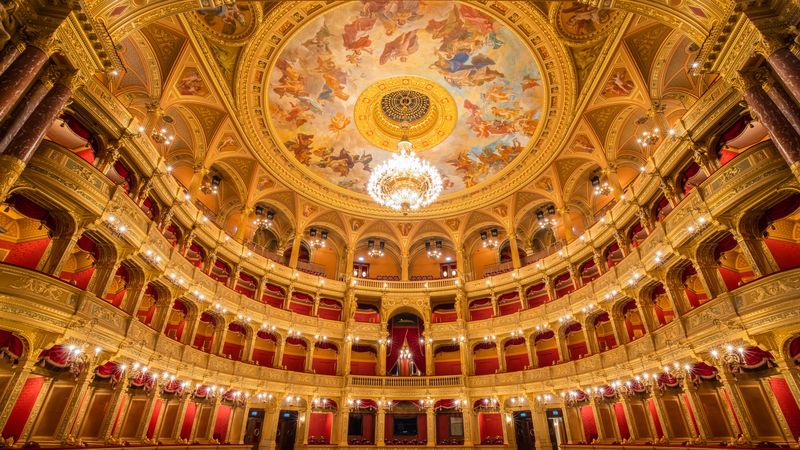
The horseshoe-shaped, three-storey auditorium provides an exhilarating feeling of space.
The enchanting world of red and gold colours and the calm, harmonious composition with the ceiling fresco and the splendid bronze chandelier hanging above it just might be the most perfect parts of this magnificent building. Although the curve of each storey, with each higher-level receding behind the one beneath it, is different, the overall sight is unified. Miklós Ybl defined the system for decorating the auditorium, with an eye on graduation and rhythm.
Audience members sitting in boxes between the gilded parapets and the elbow boards are practically part of the performance. Their clothing, behaviour, and their mere presence can be just as spectacular and interesting as the events transpiring on the stage. Who was able to buy season tickets for which box for themselves and their friends used to be a measure of wealth. Many people still prefer buying tickets to the same box year after year if possible. For people who sit here, it is important to be seen, and they are curious to see who are sitting in the other boxes and seats. The ornate decorations of the parapets and elbow boards and the twenty-four-carat gold gilding serve to further enhance the rank and pomp of the boxes.
The royal box is located in the middle. It is currently used to seat people of importance and is reserved for the three most important Hungarian heads of state and their guests. Four accompanying boxes neighbour the two-level royal box. These are home to Gyula Donáth’s allegorical statues of the Tenor, the Soprano, the Alto, and the Bass singers. To complement these, four statues of the four virtues, i.e. Prudence, Courage, Temperance, and Justice, adorn the boxes that close the horseshoe shape.
According to legend, when the Hungarian Queen, Sissi left her isolation in Gödöllő to visit the Opera from time to time, she viewed the performances from the proscenium box found at the orchestra pit and the part above the stage. This balcony has a number of advantages: if she arrived from Dalszínház Street, took the Royal Stairs, then passed through the upstairs gallery at its top, and used the oak-covered salon door, she could access this balcony without having to meet anyone.
The allegorical figures of Music and Dance frame the sides of the triptych in front of the stage, with the Genius of Art in the middle. The arches above the Corinthian columns that support the cupola enclose hexagonal fields, each of which contains a Putto who are members of the Putto orchestra that plays excerpts from the day’s performances at midnight each night to ensure that the acoustics are always perfect. Even if this is just a fairy tale, it is true that all of the paintings in the auditorium were painted by Károly Lotz.
The circular ceiling is adorned by Károly Lotz’s monumental fresco entitled The Apotheosis of Music. The light shed by the chandelier envisaged by Miklós Ybl serves to enhance the beauty of the painting.
Despite its Baroque commotion, the circular ceiling fresco, with its more than four-metre diameter and its forty-five-metre circumference, creates a perfect unity of style with the auditorium’s Renaissance feeling of calm. The composition shows Mount Olympus, where six groups of gods are listening to Apollo. In addition to the gods of order, poetry, music, dance, and the arts, the painting also features muses and the Horae, the protectors of nature and morals. The main figures in the second unit include Zeus, his wife Hera, Nike, Pallas Athena, and Hermes. The third part shows Nyx, the god of night, with the creatures of the underworld. Hades, Persephone, Hypnos (the god of sleep), and Thanatos (the god of death) also figure here. The fourth group is centred around Dionysus and includes Ariadne, Bacchae and Bacchantes, a satyr, and a centaur. The fifth unit features Poseidon, the god of the sea, and the sixth features Aphrodite, the goddess of beauty and love. The figures of the three Charites before her lead us back to Apollo. This definitive work owes its light colours to the marble powder plaster that was used, which brings to life the blue in the sky, the gold in the clouds, and the warm hues of the textiles that surround the gods. His contemporaries also recognised Károly Lotz’s main work, and today’s experts consider it one of the most prominent Hungarian frescos.
The chandelier, ordered from Mainz, was installed in the ventilation shaft in 1884. To this day, manual winches are used twice a year to lower it to the ground floor seats for maintenance and to replace any burnt out bulbs. The chandelier originally weighed three tonnes and was equipped with five hundred gas lights. Electrical wiring was passed through the gas pipelines in 1895, and the gas pipelines were then permanently removed in the 1980 renovations. The structure currently weights just about two tonnes and has more than two hundred bulbs. The dimming of these bulbs can only mean one thing: the performance is about to begin!